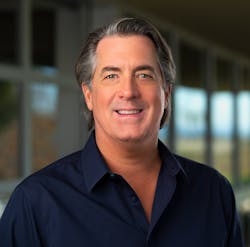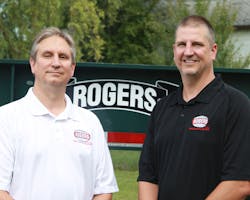The development of digital technologies, innovative software, and state-of-the-art engineering continues to evolve in the dirt-moving industry. We present to you just a handful of the visionaries who embody this spirit of invention and their commitment to achieving greater efficiencies while at the same time increasing productivity. —Arturo Santiago, Chief Editor
B2W Software – Paul McKeon
Vision has been a hallmark of B2W Software since CEO Paul McKeon founded the company in 1993 and delivered one of the first specialized software applications to move heavy construction estimators beyond the constraints of calculators and spreadsheets.
McKeon ran his own paving business while studying computer science in college. A stint after graduation as a project manager at a large road-building enterprise sparked the idea of putting the two interests together. The company’s estimating software caught on quickly, leading the industry to exponential gains in bidding speed, accuracy, and efficiency, and B2W never stood still under McKeon’s leadership.
While enhancing the feature set and performance of its estimating application continuously, the company broke new ground with a unique approach to software for managing operational workflows. The unified B2W Software ONE Platform now includes elements for resource scheduling and dispatching, field tracking and analysis, equipment maintenance, and electronic forms and reporting.
The differentiating aspect of the B2W platform is a single Microsoft SQL database for operational data on employees, equipment, and jobs. While other software approaches can leave contractors with complex integration challenges, the individual B2W operational elements use and update the common source of operational information. Data flow logically in real-time across the platform without errors, lag time, and redundant data entry. The platform also provides enterprise-class performance, construction logic, intuitive interfaces, and advanced mobile capabilities.
As jobs get more complex, competition intensifies, and margins tighten across heavy construction sectors, this visionary B2W approach will continue to provide vital opportunities for contractors to win more bids and to communicate and collaborate across interdependent workflows to operate more efficiently, optimize their resources, and make better, data-driven decisions.
Doosan Bobcat North America – Joel Honeyman
As vice president of Global Innovation at Doosan Bobcat North America, Joel Honeyman is responsible for driving a culture of innovation, partnering with leading global technology firms, and demonstrating the value of applying advanced technologies to current and new products, processes, and services.
As an innovation leader, Joel has guided his team to help Bobcat Company develop advanced technologies that connect people and machines in new and innovative ways to help operators work more efficiently and safely on the job site. Bobcat MaxControl, Bobcat Features On Demand, and Bobcat Machine IQ Wireless Communication are all new Bobcat-exclusive technologies that will expand the possibilities of how customers and operators work.
MaxControl is a suite of features that allow operators to take their machines to the next level of operation utilizing mobile technology. It allows for control of Bobcat machines outside of the cab. Additional functionality in the future will allow it to create a geofence around obstacles to avoid objects on the job site and plot GPS points for simple, semi-autonomous operation. With Bobcat Machine IQ wireless communication, Bobcat machines can be monitored from anywhere, and critical information can be recorded to decrease downtime and reduce costs. Features On Demand allows operators to purchase new R-Series compact loaders with certain features enabled at the point of sale, plus the ability to turn on other machine features after the initial sale without significant cost or machine upgrades.
Bobcat is also leading the way in developing battery-powered electric solutions in the compact equipment industry, including the new electric prototype machines and an all-electric concept loader that will be the first battery-powered electric solution offered by Bobcat.
These technologies and innovations will revolutionize compact equipment, from improved productivity and enhanced precision to more intelligent machines that bring new capabilities to the job site.
“As the global leader in compact equipment, we strive to stay ahead of each new trend and pave the way for new and innovative technologies to help our customers accomplish more. We’re continuously working to bring new technologies to the market and bring forward the machines of tomorrow. In the next 5 to 10 years, we’ll continue to see semi-autonomous technologies that will allow the operator to customize their machine to complete jobs faster, better, and safer. Whether that’s through remote control technologies, radar sensors, or semi-autonomous operation, Bobcat will continue to lead the way in innovation.” – Joel Honeyman, vice president of Global Innovation, Doosan Bobcat North America
Caterpillar Inc – Fred Rio
Fred Rio is the worldwide product manager for Caterpillar’s Construction Digital & Technology (CD&T) division, responsible for developing, executing, and growing the digital and technology business for markets represented by Construction Industries globally. The division develops technologies and site-level solutions that enhance productivity, equipment management, safety, and sustainability. The goal is to solve customer problems by leveraging expertise in both the digital and the construction realms.
Fred is a 20-year veteran of the Paving Products division and has held positions ranging from engineering through product development to sales and marketing. He is fluent in five languages and has lived throughout Europe and the Middle East, as well as in Latin and North America. Fred is passionate about working with Caterpillar’s dealers and customers to find innovative solutions to give customers a competitive edge.
How this work will contribute to the evolution of the industry: Fred leads a product group responsible for delivering site-level equipment management, productivity, and autonomy/remote control technology solutions to the construction industry. CD&T’s mission is to make customers more productive and safer by driving the digital transformation at the job site.
Cat machines generate massive amounts of data every second of every operation. Now, Caterpillar is transforming this data into a format that’s easy to access and interpret—and placing it into the palm of customers’ hands by making it available via a suite of services in an app and online.
Fred Rio predicts the technology and innovations that will be at the forefront of the industry for the coming decade: "Autonomy will have a profound impact on the construction ecosystem, potentially disrupting or challenging existing norms in relation to the size of the equipment employed, the role of dealers and OEMs, all the way to the individual operator or subcontractor."
Full autonomy may not yet be ready for the construction industry. However, numerous step changes can be taken now by balancing people, processes, and technology. Starting in Q3 of 2020, Cat Command will debut into construction with Command for Loading (928/930/938), followed by Command for Excavation (320, 323, 326, 330, 336, 340), and Command for Dozing (D6) in early 2021. Over time we expect the majority of Caterpillar machines to become compatible with the Command technology. As technology and processes change, the sophistication and adoption of automation will evolve into full autonomy. Caterpillar is committed to exploring all the options and continuing to innovate in a space where we’ve long been the industry leader.
John Deere – Kevin Very
Kevin Very is the director of technology and product marketing for the Worldwide Construction & Forestry division. Very leads the WorkSight technology group and identifies industry insights for the division’s portfolio of products and technology solutions.
Before joining Deere, Very worked in a variety of surveying, civil engineering, and construction management roles where he led engineering design and construction management for transportation and bridge projects. Very joined John Deere in 2006. In his most recent role as director of WorkSight solutions, Very led the division's focus on technology growth and solutions. He has most recently been appointed as the director of technology and product marketing for the Worldwide Construction & Forestry division.
Very holds a bachelor’s degree in civil engineering from North Dakota State University and a Master of Business Administration from the Fuqua School of Business at Duke University.
We recently announced our Smart Industrial operating model, which is designed to accelerate John Deere’s success in the integration of smart technology.
This strategy aims to unlock new value for our customers, helping them to become more profitable and sustainable while also simultaneously revolutionizing the construction industry through the rapid introduction of new technologies. Our equipment and solutions will empower our customers to perform jobs better and faster, make more informed decisions, maximize uptime, and create a complete cycle where each step informs the next.
We’ve also laid the groundwork for how we see the industry evolving as we move toward higher levels of machine and job site automation. We look at this as a journey that is built through increasing levels of technology integration that are the building blocks for future levels of automation. In the short term, these solutions better connect fleets, provide operational insights in real-time, augment tasks for operators of all skill levels, and drive higher levels of job site safety. In the long term, these are technologies that together will transform machine and job site productivity.
“Contractors are facing many challenges, from skilled labor shortages to the need for increased productivity and reduced downtime. I believe that technology is a solution to many of these challenges, and we will see more contractors adopting technology in all aspects of their business. At John Deere, we are committing our resources into researching and developing new technology solutions to help our customers be more productive and profitable.” – Kevin Very
Procore – Craig Courtemanche
Craig “Tooey” Courtemanche is the founder and CEO of Procore, a construction management software company headquartered in Carpinteria, CA. Mr. Courtemanche founded the company in 2002 and has grown it to over 2,000 employees operating out of 14 offices around the world. Today, over one million construction projects have run on the Procore platform, and more than 1.3 million users rely on Procore every day in over 125 countries. Mr. Courtemanche has been credited by Forbes for building the Cloud’s hottest technology “unicorn” by bringing software to low-tech construction sites.
Before starting Procore, Mr. Courtemanche was the founder and CEO of Webcage, a software consulting firm he ran from the San Francisco Bay Area. From 1993 to 1996, Mr. Courtemanche served as a software engineer at Skip Steveley & Associates, a consulting firm.
“I believe the advancements in both technology and construction software will play critical roles in the future success of the industry. The way buildings are built is changing. Digitization is at the center of this change, and the way people are utilizing technology is leading to greater transparency in a historically fragmented industry. Having access to insights from our data allows us to reduce waste and rework on projects. We can now learn from past projects and make better decisions going forward based on the insights from our data.” – Craig Courtemanche
Rogers Brothers Corporation – Jay Kulyk & Nick Kulyk
The responsibility to continue 115 years and four generations of family leadership and innovation in the heavy-duty trailer industry now falls squarely on the shoulders of current Rogers Brothers Corporation president, Jay Kulyk, and his brother, vice president, Nick Kulyk.
Jay joined the family business in 1991 and Nick joined in 2000. The brothers have been fortunate to benefit from the wisdom and vision of previous generations of the Kulyk family. Their grandfather, John Kulyk, was ROGERS president from 1958 to 1989. He was followed by their father, Lawrence Kulyk, from 1989 to 1994 (remaining active in the business today), and their uncle, Mark Kulyk, who was president from 1994 until his retirement in 2012. Each shared their own lessons and wisdom, but all emphasized the same principle: “In order to achieve continued success, the company must always look forward to meet or exceed the needs of our customers.”
In recent decades, ROGERS has incorporated a number of design innovations and technological advancements to our trailers. Some of the design improvements include the use of high-strength steels in the fabrication of main structural beams for lower trailer weights and deck heights, improved loading ramp designs for lower approach angles for safer loading of machines to the trailer, and continued improvement to the “Bucket Pocket” in the rear of the trailer deck to allow for lower overall loaded height of excavators. Technological advances to ROGERS trailers include Anti-lock Brake Systems (ABS) for improved braking performance and safety, the incorporation of air suspension systems for smoother ride and load distribution, and LED lighting systems for enhanced durability and performance as well as reduced electrical load requirements.
Looking forward, there are a number of component improvements that are expected to impact the design of their trailers. Disc brakes may eventually replace drum brakes to further improve vehicle braking. Electronic brake systems can provide even better vehicle control and performance by incorporating air suspension controls to the trailer braking systems, and self-steer and steerable axles make trailers more maneuverable by reducing turning radius.
A great deal of innovation to the company’s trailer designs is the result of requests from, and collaboration with, our customers to solve a particular hauling issue they may have. ROGERS takes great pride in our willingness and ability to design trailers specifically to customer’s varying needs rather than simply trying to match a customer to a current design.
In addition, changes to the designs of the various machines to be hauled by our customers on our trailers have a large impact on our trailer designs. Trailer deck lengths continue to increase and deck heights continue to decrease in order to best haul these newer machines to meet required local and state regulations.
Topcon Positioning Systems – Richard Jackson
Richard Jackson is Senior Vice President of Engineering for Machine Control at Topcon Positioning Systems. Originally from New Zealand, Jackson has been fascinated with measurement all his life. He began his career working for five years in land surveying before embarking on a degree in computer science from the University of Canterbury in Christchurch. At the age of 30, Jackson moved to the US to further develop his career. For more than 20 years since then, he has focused on bringing the use of GNSS and optical measurement technologies “down to earth” and in particular to apply these technologies to machine guidance and control applications for construction equipment.
Jackson was instrumental in the innovation of the connected job site with the development of Sitelink3D—the Topcon complete, 24/7 multiple site communication services that provide telematic information for machine control projects. It allows complete visibility to all equipment on job sites in real-time from a laptop, office desktop, or with a mobile device.
Jackson said, “The vision was clear from the start—provide real-time information to those who needed it most. Site supervisors and project managers could immediately see if their grade control equipment was running on out-of-date surface models or not running at all. And from a support and dispatch perspective, remote problem solving and daily surface updates could all be handled via Sitelink3D—saving a multitude of man-hours, machine downtime, and costly mistakes.”
“A major challenge with job site management via the ‘cloud’ has always been managing mixed grade control solutions (different grade control systems with different clouds). The good news for the construction industry is that we will gradually see standardization and interoperability thanks to global initiatives like ISO 15143-4, which should ease grade-control data sharing between machines.”










